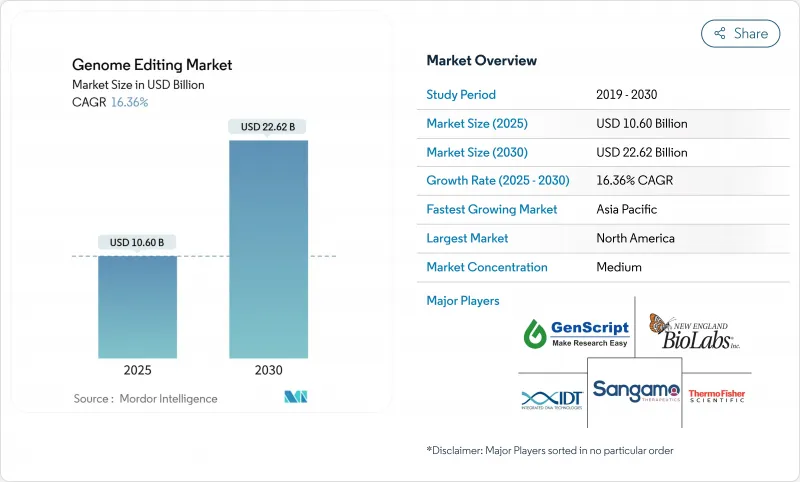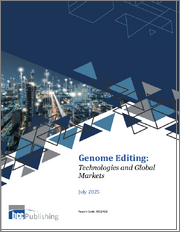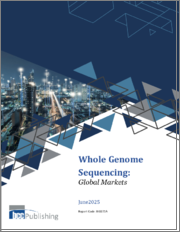
|
시장보고서
상품코드
1836631
유전자 편집 시장 : 점유율 분석, 산업 동향, 통계, 성장 예측(2025-2030년)Genome Editing - Market Share Analysis, Industry Trends & Statistics, Growth Forecasts (2025 - 2030) |
||||||
유전자 편집 시장 규모는 2025년에 106억 달러, 예측 기간(2025-2030년)의 CAGR은 16.36%를 나타내고, 2030년에는 226억 2,000만 달러에 달할 것으로 예측됩니다.

CRISPR-Cas9의 임상적 검증, 기후 변화에 강한 작물에 대한 수요 증가, 풍부한 벤처캐피탈, 이들 모두가 상업적 채택을 가속시키는 요인이 되고 있습니다. 규제 당국의 신뢰가 높아지고 있는 것은 CRISPR 치료제의 심사 지정이 잇따르고 있는 것으로부터도 분명하고, 한편, 몇개국의 농업 규제 당국은 현재, 많은 유전자 편집 식물을 관행 육종으로서 취급하고 있습니다. 경쟁 전략의 초점은 GMP 대응 능력의 확대, 뉴클레아제 설계에 AI의 통합, 지적 재산상의 우위를 확보하는 플랫폼 라이선스 계약의 체결입니다. 주요 제약 기업과 민첩한 신흥 기업 간의 협력 관계 강화는 치료 파이프라인을 확대하고 시장 출시 시간을 단축하지만, 제조 규모 확대, 무역 정책 불일치, 숙련 노동자 부족이 선행을 불투명하게 합니다.
세계 유전자 편집 시장 동향과 통찰
임상시험에서 CRISPR-Cas 시스템의 신속한 채택
최초의 CRISPR 요법이 FDA에 승인됨으로써, 보다 광범위한 임상시험이 이루어지게 되어, 개발 사이클을 최대 2년 단축하는 멀티암 엄브렐러 시험이 가능하게 되었습니다. 혈액학, 안과학, 고형 종양 연구의 좋은 결과는 플랫폼의 다양성을 강조하고 지속적인 자본 유입을 유도합니다. 대학과 생명 공학 회사는 CRISPR-TIL 프로토콜을 확장하고 소화기 암으로 완전한 효능을 달성하며 단발성 적응증을 뛰어 넘고 있습니다.
기후 변화에 강한 작물에 대한 농업 생명공학 수요 증가
유전자 편집 쌀, 가뭄 내성 옥수수, 내열성 가축은 수율을 유지하면서 기후 충격을 완화하는 솔루션의 예입니다. 외래 DNA가 존재하지 않는 16개의 관할 구역에서의 규제 면제는 상업화를 가속화시켜 소규모 육종가가 부담이 큰 유전자 변형 작물의 장애물 없이 유전자 편집 시장에 진입할 수 있게 합니다. 관민 프로그램은 CRISPR 도구를 주식 작물의 영양 강화에 활용하고 신흥국 시장에서 시장 개척의 기회를 넓히고 있습니다.
인간의 장기적인 오프 타겟 안전성 프로파일은 불확실
초심도 시퀀싱은 수백 개의 잠재적 오프 타겟 부위를 밝혀내고 있으며, 규제 당국은 후기 임상시험을 진행하기 전에 생물학적 분포와 내구성 시험의 확대를 요구하고 있습니다. 높은 충실도의 Cas 변이체와 프라임 편집 접근법은 위험을 완화하지만, 인간의 장기 데이터가 제한되어 있기 때문에 특히 EU에서는 상용 조사 요구 사항이 엄격해지고 있습니다.
보고서에서 분석된 기타 촉진요인 및 억제요인
- 유전자 편집 스타트업에의 VC 및 IPO에 의한 자금 조달의 급증
- 희귀질환을 위한 생체내 유전자 편집 치료제의 주류화
- GMP 호환 유전자 편집 제조 제품군을위한 고액 CAPEX
부문 분석
2024년 유전자 편집 시장 점유율은 CRISPR이 41.62%를 차지하지만, TALEN은 19.89%의 연평균 복합 성장률(CAGR)로 경쟁 믹스를 재구성하고 있습니다. 진화하는 AI 툴은 가이드 RNA 최적화 사이클을 극적으로 단축하고, 뉴클레아제 설계 영역을 확대하며, 새로운 서열 상동성을 가진 Open-CRISPR과 같은 파생 기술을 만들어 냅니다. 염기 편집 및 프라임 편집 기술은 안전성을 중시하는 대체 수단으로 지원을 수집하고, 특히 이중 가닥 절단의 위험에 민감한 적응 영역에서 전용 서브 마켓을 열 수 있습니다.
동시에, 징크 핑거 뉴클레아제는 지적 재산의 자유도가 처리량을 능가하는 초특이적 적용에서 틈새를 유지합니다. 메가뉴클레아제 및 올리고뉴클레오티드 지향성 돌연변이유발은 산업적 합성 생물학 워크플로우의 툴킷을 완성합니다. 결과적으로 플랫폼 공급자는 점점 더 많은 편집 스타일을 예측 AI 소프트웨어 및 스크리닝 라이브러리와 번들로 제공하고 있으며, 치료, 농업 및 산업의 각 고객에 걸친 광범위한 솔루션 판매를 지원합니다.
바이러스 벡터는 예측 가능한 도입 효율과 잘 이해된 규제 경로를 통해 2024년 매출의 46.72%를 창출하여 가치가 높은 생체외 치료에 대한 지속적인 수요를 확보했습니다. 그러나 일렉트로포레이션, 마이크로플루이딕스 스퀴즈, 조직 선택적 지질 나노입자가 바이러스 시스템 특유의 면역원성과 페이로드 크기 제한을 해결하기 때문에 비바이러스 물리적 접근은 CAGR16.52%로 확대될 것으로 보입니다.
로봇에 의한 마이크로인젝션 플랫폼은 배아 편집 처리량을 4배로 높여 농업 육종가가 비바이러스 프로토콜을 대규모로 채택하는데 박차를 가하고 있습니다. 리보핵단백질 복합체는 일시적인 편집을 수행하고 적응 면역이 발동하기 전에 페이드아웃하기 때문에 반복 투여가 필요한 만성 질환 프로그램에 매력적입니다. 화학적 운반체는 스크리닝 및 조사에 적합하지만 임상 환경에서는 보다 효율적인 물리적 도구를 대체합니다.
지역별 분석
북미는 2024년 매출의 41.25%를 차지하며, 풍부한 벤처 자금, 선진적인 임상시험 인프라, FDA 지원 정책에 의해 지원되고 있습니다. 연방 정부의 바이오 이코노미 이니셔티브는 수십억 달러 규모의 예산을 유전체학 연구 개발 및 첨단 제조에 할당하여 국내 공급망을 강화하고 있습니다. 그럼에도 불구하고 건설비 인플레이션과 GMP 요원 부족이 신규 시설 운영비 상승 압력입니다.
유럽은 세계 최고 수준의 학술 연구와 농업의 상업화를 늦추는 단편적 규제를 겸비하고 있습니다. 대부분의 유전자 편집 작물에 대한 EU의 유전자 변형 작물 지정은 영국과 스위스의 보다 관용적인 자세와 대립하고 있어 정책의 조화를 요구하는 목소리가 높아지고 있습니다. 한편, 생명공학 투자펀드와 호라이즌 유럽의 보조금은 무역정책 불확실성에도 불구하고 연구개발을 유지하고 치료 프로그램에 자원을 투입하고 있습니다.
아시아태평양은 CAGR 20.23%에서 가장 급성장하고 있는 지역으로, 중국의 산업정책상의 우대조치, 일본의 유전자 편집식품에 관한 규제의 합리화, GDP에 80억 달러의 공헌을 목표로 하는 호주 RNA 블루프린트에 추진되고 있습니다. 인도의 위험 단계적 지침은 저위험 편집에 신속한 길을 열어 신흥 기업의 형성을 촉진합니다. 기술 이전의 제한과 특허 풀 협상은 해외에서 시장 진출의 궤도를 형성합니다.
기타 혜택 :
- 엑셀 형식 시장 예측(ME) 시트
- 3개월간의 애널리스트 서포트
목차
제1장 서론
- 조사의 전제조건과 시장 정의
- 조사 범위
제2장 조사 방법
제3장 주요 요약
제4장 시장 상황
- 시장 개요
- 시장 성장 촉진요인
- 임상시험에서의 CRISPR-Cas 시스템의 급속한 채택
- 기후 변화에 강한 작물에 대한 농업 생명공학 수요 증가
- 유전자 편집 스타트업에의 VC 및 IPO에 의한 자금 조달의 급증
- 희귀질환을 위한 생체내 유전자 편집 치료제의 주류화
- 자동화와 AI에 의한 고처리량 스크리닝 플랫폼
- 신흥국의 정부의 바이오 경제 로드맵
- 시장 성장 억제요인
- 인간에서의 장기적인 표적외 안전성 프로파일이 불명확
- GMP 준거의 유전자 편집 제조 스위트에 걸리는 고액의 CAPEX
- 편집 종자에 관한 국경을 넘은 규제의 분단
- 고도의 분자 생물학 스킬 세트의 인재 부족
- Porter's Five Forces 분석
- 신규 참가업체의 위협
- 구매자의 협상력
- 공급기업의 협상력
- 대체품의 위협
- 경쟁 기업간 경쟁 관계
제5장 시장 규모 및 성장 예측(단위 : 달러)
- 기술별
- 클러스터링 규칙적 인터스페이스 짧은 팔린드롬 반복(CRISPR)
- 전사 액티베이터 라이크 이펙터 뉴클레아제(TALEN)
- 징크 핑거 뉴클레아제(ZFN)
- 메가뉴클레아제
- 올리고뉴클레오티드 지향성 돌연변이유발(ODM)
- 기타 기술
- 전달 방법별
- 바이러스 벡터
- 비바이러스 물리적 방법
- 비바이러스성 화학적 방법
- 용도별
- 세포주 공학
- 유전자 및 세포 치료
- 약물 발견 및 기능 유전체학
- 농작물 공학
- 진단 및 합성 생물학
- 최종 사용자별
- 제약 및 바이오테크놀러지 기업
- 학술 및 정부 연구소
- 수탁연구기관
- 농업 및 식품 회사
- 지역별
- 북미
- 미국
- 캐나다
- 멕시코
- 유럽
- 독일
- 영국
- 프랑스
- 이탈리아
- 스페인
- 기타 유럽
- 아시아태평양
- 중국
- 일본
- 인도
- 호주
- 한국
- 기타 아시아태평양
- 중동 및 아프리카
- GCC
- 남아프리카
- 기타 중동 및 아프리카
- 남미
- 브라질
- 아르헨티나
- 기타 남미
- 북미
제6장 경쟁 구도
- 시장 집중도
- 시장 점유율 분석
- 기업 프로파일
- Thermo Fisher Scientific Inc.
- Merck KGaA(Sigma-Aldrich)
- CRISPR Therapeutics AG
- Editas Medicine Inc.
- Horizon Discovery Group plc
- Intellia Therapeutics Inc.
- Beam Therapeutics Inc.
- Sangamo Therapeutics Inc.
- GenScript Biotech Corporation
- Synthego Corporation
- Takara Bio Inc.
- Integrated DNA Technologies Inc.
- Lonza Group AG
- New England Biolabs Inc.
- OriGene Technologies Inc.
- Caribou Biosciences Inc.
- Bluebird Bio Inc.
- Bio-Rad Laboratories Inc.
- Agilent Technologies Inc.
- QIAGEN NV
제7장 시장 기회와 전망
SHW 25.10.28The Genome Editing Market size is estimated at USD 10.60 billion in 2025, and is expected to reach USD 22.62 billion by 2030, at a CAGR of 16.36% during the forecast period (2025-2030).

Clinical validation of CRISPR-Cas9, rising demand for climate-resilient crops, and abundant venture capital all converge to accelerate commercial adoption. Growing regulatory confidence is evident in the wave of review designations granted to CRISPR therapeutics, while agricultural regulators in several countries now treat many gene-edited plants as conventionally bred. Competitive strategies focus on expanding GMP-compliant capacity, integrating AI into nuclease design, and signing platform licensing deals that lock in intellectual-property advantages. Intensifying collaboration between large pharmaceutical companies and agile start-ups broadens the therapeutic pipeline and speeds time-to-market, even as manufacturing scale-up, trade policy misalignment, and skilled-labor shortages temper the outlook.
Global Genome Editing Market Trends and Insights
Rapid Adoption of CRISPR-Cas Systems in Clinical Trials
FDA approval of the first CRISPR therapy unlocked broader clinical exploration, enabling multi-arm umbrella trials that cut development cycles by up to two years. Positive read-outs from hematology, ophthalmology, and solid-tumor studies underscore platform versatility and attract sustained capital inflows. Universities and biotech firms are scaling CRISPR-TIL protocols that achieved complete responses in gastrointestinal cancers, moving beyond monogenic indications.
Expanding Agricultural Biotechnology Demand for Climate-Resilient Crops
Genome-edited rice, drought-tolerant corn, and heat-resistant livestock exemplify solutions that mitigate climate shocks while maintaining yield. Regulatory exemptions in 16 jurisdictions where no foreign DNA persists accelerate commercialization, allowing small breeders to enter the genome editing market without onerous GMO hurdles. Public-private programs channel CRISPR tools toward nutritional fortification in staple crops, broadening market opportunities in developing regions.
Uncertain Long-Term Off-Target Safety Profile in Humans
Ultra-deep sequencing continues to reveal hundreds of potential off-target sites, prompting regulators to demand expanded biodistribution and durability studies before late-stage trials can proceed. High-fidelity Cas variants and prime-editing approaches lessen risk, but limited long-term human data keep post-marketing surveillance requirements stringent, especially in the EU.
Other drivers and restraints analyzed in the detailed report include:
- Surging VC & IPO Funding for Gene-Editing Start-Ups
- Mainstreaming In-Vivo Gene-Editing Therapeutics for Rare Diseases
- High CAPEX For GMP-Compliant Gene-Editing Manufacturing Suites
For complete list of drivers and restraints, kindly check the Table Of Contents.
Segment Analysis
CRISPR delivered 41.62% genome editing market share in 2024, but TALEN exhibits a 19.89% CAGR that is reshaping the competitive mix. Evolving AI tools dramatically cut guide-RNA optimization cycles and expand the nuclease design space, spawning derivatives such as Open-CRISPR with novel sequence homology. Base- and prime-editing modalities gain traction as safety-oriented alternatives and may carve dedicated submarkets, especially in indication areas sensitive to double-strand break risks.
At the same time, zinc finger nucleases preserve niches in ultra-specific applications where intellectual-property freedom outweighs throughput. Meganucleases and oligonucleotide-directed mutagenesis round out the toolkit for industrial synthetic-biology workflows. Consequently, platform providers increasingly bundle editing modalities with predictive AI software and screening libraries, anchoring broader solution sales across therapeutic, agricultural, and industrial customers.
Viral vectors generated 46.72% of 2024 revenue through predictable transduction efficiency and a well-understood regulatory path, ensuring continued demand in high-value ex-vivo therapies. Yet non-viral physical approaches will expand at 16.52% CAGR as electroporation, microfluidic squeezing, and tissue-selective lipid nanoparticles solve the immunogenicity and payload-size limits inherent to viral systems.
Robotic microinjection platforms quadruple embryo-editing throughput, spurring agricultural breeders to adopt non-viral protocols at scale. Ribonucleoprotein complexes deliver transient editing that fades before adaptive immunity triggers, appealing to chronic-disease programs requiring repeat dosing. Chemical carriers remain relevant for screening and research but cede ground in clinical settings to more efficient physical tools.
The Genome Editing Market Report Segments the Industry Into by Technology (Clustered Regularly Interspaced Short Palindromic Repeats (CRISPR), and More), Delivery Method (Viral Vectors, and More), Application (Cell Line Engineering, and More), by End User (Pharmaceutical & Biotechnology Companies, and More), and Geography (North America, Europe, Asia-Pacific, and More). The Market Forecasts are Provided in Terms of Value (USD).
Geography Analysis
North America captured 41.25% of 2024 revenue, anchored by deep venture funding, leading clinical-trial infrastructure, and supportive FDA policies. Federal bio-economy initiatives allocate multi-billion-dollar budgets to genomics R&D and advanced manufacturing, reinforcing domestic supply chains. Nonetheless, construction-cost inflation and scarcity of GMP personnel place upward pressure on operating expenses for new facilities.
Europe combines world-class academic research with fragmented regulations that slow agricultural commercialization. The EU's GMO designation for most gene-edited crops conflicts with more permissive stances in the United Kingdom and Switzerland, prompting calls for policy harmonization. Meanwhile, biotech investment funds and Horizon Europe grants channel resources into therapeutic programs, sustaining R&D despite trade-policy uncertainty.
Asia-Pacific is the fastest-growing region at 20.23% CAGR, propelled by Chinese industrial-policy incentives, Japanese regulatory streamlining for genome-edited foods, and Australia's RNA Blueprint aiming for an USD 8 billion contribution to GDP. India's risk-tiered guidelines create an expedited path for low-risk edits, catalyzing start-up formation. Technology-transfer limits and patent-pool negotiations will shape the trajectory of foreign market entrants.
- Thermo Fisher Scientific
- Merck
- CRISPR Therapeutics AG
- Editas Medicine
- Horizon Discovery
- Intellia Therapeutics Inc.
- Beam Therapeutics Inc.
- Sangamo Therapeutics
- Genscript
- Synthego Corporation
- Takara Bio
- Integrated DNA Technologies
- Lonza Group
- New England Biolabs
- OriGene Technologies
- Caribou Biosciences Inc.
- Bluebird Bio
- Bio-Rad Laboratories
- Agilent Technologies
- QIAGEN
Additional Benefits:
- The market estimate (ME) sheet in Excel format
- 3 months of analyst support
TABLE OF CONTENTS
1 Introduction
- 1.1 Study Assumptions & Market Definition
- 1.2 Scope of the Study
2 Research Methodology
3 Executive Summary
4 Market Landscape
- 4.1 Market Overview
- 4.2 Market Drivers
- 4.2.1 Rapid Adoption of CRISPR-Cas Systems in Clinical Trials
- 4.2.2 Expanding Agricultural Biotechnology Demand for Climate-Resilient Crops
- 4.2.3 Surging VC & IPO Funding for Gene-Editing Start-Ups
- 4.2.4 Mainstreaming In-Vivo Gene-Editing Therapeutics for Rare Diseases
- 4.2.5 Automation & AI-Assisted High-Throughput Screening Platforms
- 4.2.6 Government Bio-Economy Roadmaps in Emerging Countries
- 4.3 Market Restraints
- 4.3.1 Uncertain Long-Term Off-Target Safety Profile in Humans
- 4.3.2 High CAPEX For GMP-Compliant Gene-Editing Manufacturing Suites
- 4.3.3 Cross-Border Regulatory Fragmentation for Edited Seeds
- 4.3.4 Talent Shortage in Advanced Molecular Biology Skillsets
- 4.4 Porter's Five Forces Analysis
- 4.4.1 Threat of New Entrants
- 4.4.2 Bargaining Power of Buyers
- 4.4.3 Bargaining Power of Suppliers
- 4.4.4 Threat of Substitutes
- 4.4.5 Competitive Rivalry
5 Market Size & Growth Forecasts (Value in USD)
- 5.1 By Technology
- 5.1.1 Clustered Regularly Interspaced Short Palindromic Repeats (CRISPR)
- 5.1.2 Transcription Activator-Like Effector Nuclease (TALEN)
- 5.1.3 Zinc Finger Nuclease (ZFN)
- 5.1.4 Meganucleases
- 5.1.5 Oligonucleotide-directed Mutagenesis (ODM)
- 5.1.6 Other Technologies
- 5.2 By Delivery Method
- 5.2.1 Viral Vectors
- 5.2.2 Non-viral Physical Methods
- 5.2.3 Non-viral Chemical Methods
- 5.3 By Application
- 5.3.1 Cell Line Engineering
- 5.3.2 Gene & Cell Therapy
- 5.3.3 Drug Discovery & Functional Genomics
- 5.3.4 Agricultural Crop Engineering
- 5.3.5 Diagnostics & Synthetic Biology
- 5.4 By End User
- 5.4.1 Pharmaceutical & Biotechnology Companies
- 5.4.2 Academic & Government Research Institutes
- 5.4.3 Contract Research Organizations
- 5.4.4 Agriculture & Food Companies
- 5.5 By Geography
- 5.5.1 North America
- 5.5.1.1 United States
- 5.5.1.2 Canada
- 5.5.1.3 Mexico
- 5.5.2 Europe
- 5.5.2.1 Germany
- 5.5.2.2 United Kingdom
- 5.5.2.3 France
- 5.5.2.4 Italy
- 5.5.2.5 Spain
- 5.5.2.6 Rest of Europe
- 5.5.3 Asia-Pacific
- 5.5.3.1 China
- 5.5.3.2 Japan
- 5.5.3.3 India
- 5.5.3.4 Australia
- 5.5.3.5 South Korea
- 5.5.3.6 Rest of Asia-Pacific
- 5.5.4 Middle East & Africa
- 5.5.4.1 GCC
- 5.5.4.2 South Africa
- 5.5.4.3 Rest of Middle East & Africa
- 5.5.5 South America
- 5.5.5.1 Brazil
- 5.5.5.2 Argentina
- 5.5.5.3 Rest of South America
- 5.5.1 North America
6 Competitive Landscape
- 6.1 Market Concentration
- 6.2 Market Share Analysis
- 6.3 Company Profiles (includes Global level Overview, Market level overview, Core Segments, Financials as available, Strategic Information, Market Rank/Share for key companies, Products & Services, and Recent Developments)
- 6.3.1 Thermo Fisher Scientific Inc.
- 6.3.2 Merck KGaA (Sigma-Aldrich)
- 6.3.3 CRISPR Therapeutics AG
- 6.3.4 Editas Medicine Inc.
- 6.3.5 Horizon Discovery Group plc
- 6.3.6 Intellia Therapeutics Inc.
- 6.3.7 Beam Therapeutics Inc.
- 6.3.8 Sangamo Therapeutics Inc.
- 6.3.9 GenScript Biotech Corporation
- 6.3.10 Synthego Corporation
- 6.3.11 Takara Bio Inc.
- 6.3.12 Integrated DNA Technologies Inc.
- 6.3.13 Lonza Group AG
- 6.3.14 New England Biolabs Inc.
- 6.3.15 OriGene Technologies Inc.
- 6.3.16 Caribou Biosciences Inc.
- 6.3.17 Bluebird Bio Inc.
- 6.3.18 Bio-Rad Laboratories Inc.
- 6.3.19 Agilent Technologies Inc.
- 6.3.20 QIAGEN N.V.
7 Market Opportunities & Future Outlook
- 7.1 White-space & Unmet-Need Assessment

















